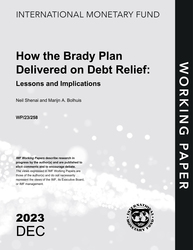
How the Brady Plan Delivered on Debt Relief: Lessons and Implications
How the Brady Plan Delivered on Debt Relief: Lessons and Implications
READ MORE...
Volume/Issue:
Volume 2023
Issue 258
Publication date: December 2023
ISBN: 9798400262685
$20.00
Add to Cart by clicking price of the language and format you'd like to purchase
Available Languages and Formats
| English |
Prices in red indicate formats that are not yet available but are forthcoming.
Topics covered in this book
This title contains information about the following subjects.
Click on a subject if you would like to see other titles with the same subjects.
Exports and Imports , Economics- Macroeconomics , Public Finance , Economics / General , Brady Plan , sovereign debt restructuring , debt relief , debt sustainability , differences-in-differences , synthetic control method , stock reduction , Brady deal , IMF program performance , IMF working paper 23/258 , Brady country , Debt restructuring , Structural reforms , Caribbean , Global
Summary
Rising debt vulnerabilities in low- and middle-income countries have rekindled interest in a Brady Plan-style mechanism to facilitate debt restructurings. To inform this debate, this paper analyzes the impact of the original Brady Plan by comparing macroeconomic outcomes of 10 Brady countries to 40 other emerging markets and developing economies. The paper finds that following the first Brady restructuring in 1990, Brady countries experienced substantial declines in public and external debt burdens and a sharp pick-up in output and productivity growth, anchored by a comparatively strong structural reform effort. The impact of the Brady Plan on overall debt burdens was many times greater than initial face value reductions, indicating the existence of a “Brady multiplier.” Brady restructurings took longer to complete than non-Brady restructurings. Today, similar mechanisms could be helpful in delivering meaningful debt stock reduction when solvency challenges are acute, but Brady-style mechanisms alone would not solve existing challenges in the sovereign debt landscape, including those related to creditor coordination, domestic barriers to economic reforms, and the increased prevalence of domestic debt, among others.
Copyright © 2010 - 2025
Powered by:
AIDC



